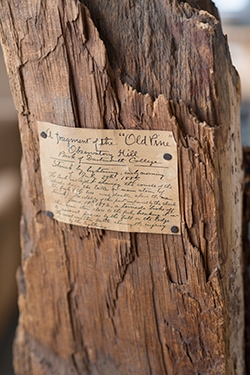Read the full story, published in the March/April 2014 issue of Dartmouth Alumni Magazine.

To tell the story of Dartmouth through artifacts and objects both historic and modern, few people would select the same items. It’s a daunting exercise that requires sifting through thousands of possibilities, some obvious, some obscure. After careful consideration—and a few arguments—Dartmouth Alumni Magazine presents its final 50. From a weathered book of Scripture, circa 1743, to a dirty pair of 2013 running spikes, the things that make Dartmouth different are the things that make Dartmouth.
Lone Pine
Nothing symbolizes Dartmouth’s history, mythology, poetry, and traditions better than the Lone Pine (originally known as the Old Pine). The tree—which stood on the hill behind the observatory—became known as a gathering place for graduating seniors by 1828. Around the same time stories circulated about American Indians singing at the same spot. It became the location of Class Day in 1854. After suffering damage in an 1887 lightning strike and an 1892 windstorm, the tree was cut down in 1895. Experts counted rings and dated it to 1783. This remnant is kept in a locked storage room at Special Collections. The pine’s reputation continued to grow posthumously: It was admitted into the American Forestry Association National Hall of Fame in 1922 and was cited by the U.S. Department of Agriculture as a “Famous Tree” in 1938. In 1967 the Class of 1927 planted an homage to the Lone Pine: This Dartmouth Pine grows at the entrance to the Bema.
